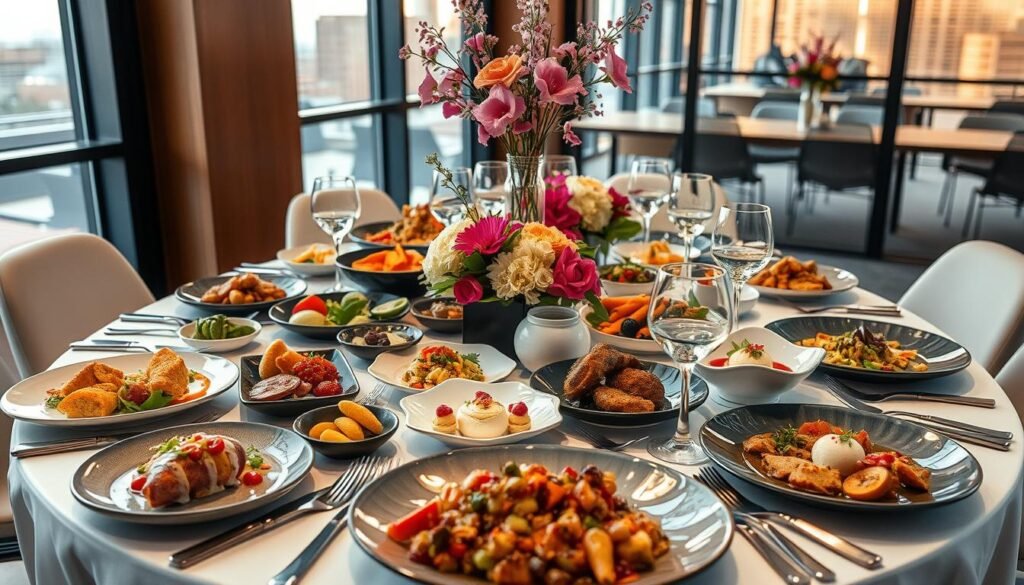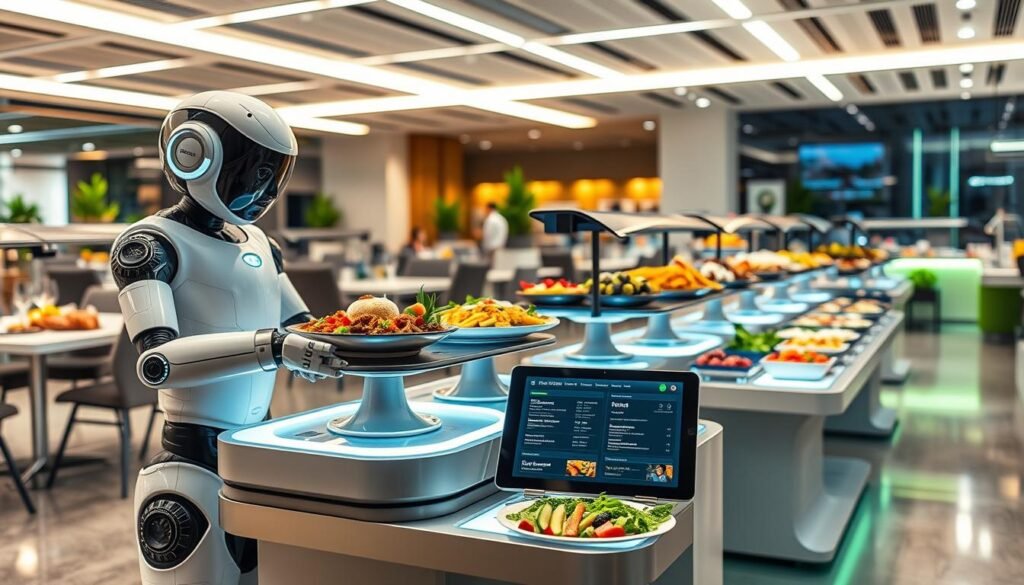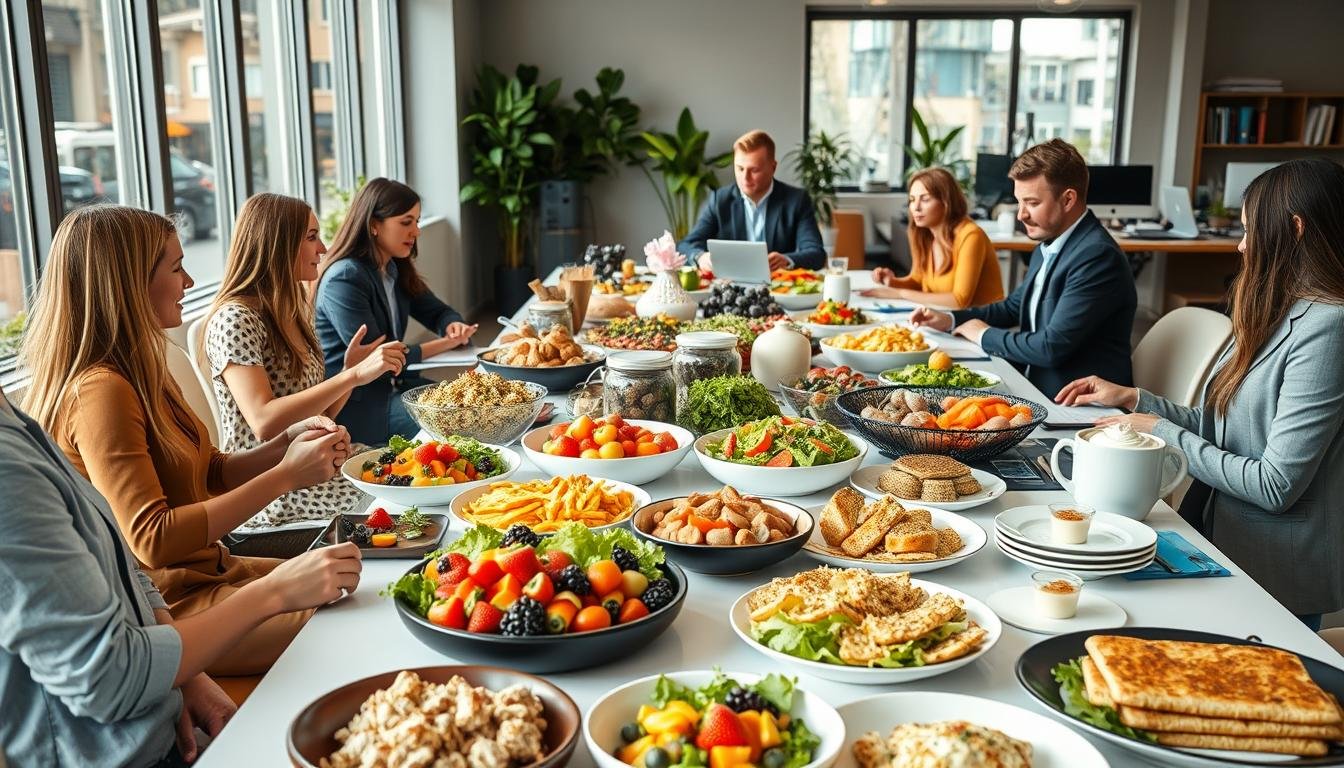Consider the profound impact a meal can have on workplace dynamics. In today’s fast-paced corporate landscape, office catering transcends mere sustenance. It emerges as a pivotal strategy to elevate employee morale and team collaboration. By investing in business catering, companies not only provide employees with delectable and convenient meals but also cultivate an environment conducive to focus and productivity. Studies indicate that prioritizing corporate catering leads to notable enhancements in teamwork and employee satisfaction.
The importance of office catering cannot be overstated. It facilitates team bonding through shared meals and meaningful conversations, thereby strengthening relationships and collaboration. Moreover, opting for local caterers ensures the delivery of fresh, high-quality meals, demonstrating the company’s dedication to employee well-being. For those seeking healthy meal options for their team, this resource offers a plethora of ideas.
Key Takeaways
- Office catering enhances employee morale and productivity.
- Corporate catering can transform work relationships.
- Investing in business catering can lead to improved teamwork.
- Fresh, delicious meals motivate employees to engage more fully.
- Choosing local catering increases meal quality and supports the community.
- A well-thought-out catering strategy creates an inviting workplace atmosphere.
Understanding the Importance of Office Catering
Office catering emerges as a pivotal element in shaping a conducive workplace ambiance. The provision of meals during work-related gatherings profoundly influences employee morale and cultivates team synergy. These communal experiences yield manifold advantages, elevating both personal contentment and collective efficiency.
Boosting Employee Morale
Studies affirm that employees perceive greater value when meals are integrated into work events. A survey discloses that 68% of employees exhibit heightened motivation when meals are a component of meetings. This surge in morale not only results in more contented employees but also contributes to a more dynamic workplace environment.
Enhancing Team Collaboration
Office catering fosters team collaboration by facilitating bonding through shared meals. Colleagues, coming together to partake in food, create avenues for networking and relationship enhancement. Such interactions catalyze enhanced communication and cooperation within teams, thereby augmenting the organization’s overall productivity.
Types of Office Catering Services
The selection of catering services profoundly influences the efficacy of an office gathering. Varied modalities cater to disparate requirements and inclinations, ensuring each event’s success through the provision of delectable sustenance. An examination of prevalent alternatives, encompassing buffet, drop-off, and full-service catering, elucidates their utility in meeting diverse needs.
Buffet Style Catering
Buffet catering fosters a convivial ambiance, permitting guests to self-serve. This modality promotes social interaction as individuals congregate while crafting their meals. It is frequently chosen for large-scale events, where the necessity for variety is paramount. This approach enriches the dining experience by offering a plethora of dishes, thereby catering to a broad spectrum of palates. It is notably advantageous for informal gatherings, luncheons, or jubilant celebrations.
Drop-off Catering
Drop-off catering epitomizes convenience, delivering prepared meals that necessitate minimal setup at the venue. This service’s adaptability in scheduling makes it ideal for time-sensitive meetings or training sessions. It allows teams to partake in a delightful repast without the burden of elaborate planning or personnel, rendering it a preferred option for routine corporate events.
Full-service Catering
Full-service catering embodies a comprehensive strategy, encompassing food preparation, service, and cleanup. This service is accompanied by dedicated personnel who guarantee the event’s seamless execution. It is particularly suited for formal gatherings, conferences, or extensive meetings where meticulous attention to detail is imperative. This form of catering ensures an opulent experience, enabling hosts to concentrate on their guests’ enjoyment.
Each catering service type caters to distinct objectives, necessitating the selection of the most appropriate for the event’s context. For a deeper exploration of the myriad corporate catering services, refer to this resource to facilitate your decision-making process.
Planning an Effective Office Catering Menu
The creation of an optimal catering menu necessitates a meticulous examination of multiple variables. It is imperative to grasp the nuances of employee dietary preferences, ensuring inclusivity and contentment among all. Surveys indicate a substantial proportion of employees harbor specific dietary restrictions, necessitating their consideration. Furthermore, the integration of seasonal ingredients not only amplifies the flavors of the dishes but also champions local agriculture and environmental stewardship.
Analyzing Dietary Preferences
In the realm of menu planning, it is paramount to present a variety of options that align with diverse dietary inclinations. The inclusion of:
- Vegetarian dishes
- Vegan options
- Gluten-free selections
- Protein-rich meals
Given that approximately 38% of employees articulate specific dietary requirements, offering a broad spectrum of choices guarantees a gratifying dining experience for all.
Incorporating Seasonal Ingredients
Seasonal ingredients are instrumental in elevating the quality and allure of your catering offerings. The procurement of fresh, in-season produce not only augments the palatability of the dishes but also fosters eco-conscious practices. By selecting items that are locally sourced, you forge a sustainable menu that also bolsters community farmers.
Benefits of Local Catering Companies
Engaging with local catering entities significantly enriches the office dining experience. These entities not only elevate the caliber of the culinary offerings but also contribute positively to the community’s well-being.
Supporting Local Businesses
Opting for local catering services is a decision that bolsters the local economy. It fosters a sense of unity among community members. Local caterers, being well-versed in the area’s gastronomic landscape, can curate menus that showcase the region’s unique flavors. This choice not only enhances the dining experience but also has a positive social impact.
Freshness and Quality
Local catering companies’ primary advantage lies in their ability to procure fresh ingredients. This ensures that the meals served are not only of superior quality but also contribute to employee satisfaction. By sourcing ingredients from nearby farms and markets, these caterers provide meals that are not only more nutritious but also more flavorful. The swift delivery of these meals ensures a seamless catering experience. For further insights, visit this link to discover how local catering can transform your office events.
Special Occasion Catering Needs
Special occasion catering is pivotal in marking significant events, such as company milestones and retreats. By customizing the catering experience, these celebrations are not only elevated but also serve to strengthen team cohesion and collaboration.
Celebrating Milestones
Acknowledging milestones is fundamental to cultivating a positive workplace culture. Whether it’s a company anniversary or an individual’s achievement, these celebrations have a profound impact on employee morale. A meticulously planned catering service can turn these events into memorable experiences. By crafting menus that resonate with the event’s significance, every dish contributes to the celebratory ambiance.
Hosting Company Retreats
Company retreats provide a unique setting for fostering organizational unity outside the office environment. These gatherings necessitate meticulous meal planning, where event catering becomes indispensable. A thoughtfully designed menu caters to diverse dietary needs while aligning with the retreat’s goals, fostering a sense of unity and participation among attendees. To leave a lasting impression, incorporate themed elements that echo the retreat’s ethos.
Budgeting for Office Catering
Effective budgeting is paramount when planning office catering to ensure a successful event without financial overreach. Understanding the intricacies of cost breakdown is essential for managing expenses while maintaining quality service.
Cost Per Person Breakdown
Calculating the cost per person is often the initial step in establishing the overall budget for office catering. This calculation typically considers:
- Guest count
- Menu selection
- Additional services offered by the caterer
By evaluating these factors, one can better anticipate the total expenditure and make informed decisions on menu options that align with the financial plan.
How to Stay Within Budget
Staying within budget necessitates strategic planning. Caterers frequently offer package deals that include several menu items at a fixed price. These packages can simplify cost control. Other tips include:
- Anticipating additional costs such as gratuity
- Factoring in service fees
- Considering off-peak event timing for better rates
- Negotiating with local catering companies for discounts
By employing these budgeting strategies, businesses can enjoy excellent office catering experiences without exceeding their financial limits.
Choosing the Right Catering Partner
The selection of a catering partner is paramount for the triumph of any corporate event. A myriad of considerations will shape your choice. A comprehensive assessment guarantees that your catering aligns with both financial and gastronomic expectations.
Factors to Consider
Begin by scrutinizing the following elements when selecting your catering partner:
- Menu Variety: A varied menu accommodates diverse palates and dietary needs.
- Service Style: Choose between buffet, plated service, or drop-off meal options, contingent upon your event’s requirements.
- Cost: Familiarize yourself with the pricing model to circumvent unforeseen expenses.
Checking References and Reviews
Seeking testimonials and references offers invaluable insights into a caterer’s dependability. Online reviews also hold significant weight. Platforms such as Yelp and Google frequently showcase customer satisfaction, unveiling crucial details about a caterer’s service caliber. For additional advice, peruse some useful tips on selecting the ideal caterer your corporate gathering. Ensuring your catering partner boasts positive feedback can profoundly influence your overall event experience.
Dietary Restrictions and Allergens
The imperative of comprehending dietary restrictions in the formulation of an office catering menu cannot be overstated. As the prevalence of employees necessitating diverse meal options escalates, the provision of vegetarian and gluten-free menus emerges as a critical imperative. Such inclusivity not only underscores a company’s cognizance of varied employee requirements but also cultivates a more expansive and welcoming dining atmosphere.
Vegetarian and Vegan Options
The inclusion of vegetarian options is paramount for those adhering to plant-based diets, ensuring their participation in communal dining experiences. A diverse array of dishes, such as:
- Quinoa salads with seasonal vegetables
- Stuffed bell peppers
- Vegetable stir-fries
Extending this inclusivity to vegan options further amplifies the appeal, guaranteeing that no individual is precluded from partaking in delectable culinary offerings due to dietary restrictions.
Gluten-Free Menus
The creation of gluten-free menus is indispensable for employees afflicted with celiac disease or gluten intolerance. This ensures an environment where all participants can partake in the meal without apprehension. Caterers must clearly delineate dishes and offer alternatives such as:
- Salads with gluten-free dressings
- Rice or quinoa-based meals
- Desserts devoid of wheat flour
By explicitly highlighting dietary restrictions through clear labeling and communication regarding allergens, the overall catering experience is significantly enhanced. This approach not only encourages the adoption of health-conscious choices but also ensures safety and satisfaction during office gatherings.
The Role of Presentation in Catering

Effective catering presentation is paramount in elevating the dining experience. An inviting environment not only enhances the meal but also sets the event’s tone. Upon entering a well-decorated space, guests feel welcomed and valued. The visual appeal of food arrangements significantly impacts their enjoyment, making the meal unforgettable.
Creating an Inviting Environment
Creating an inviting environment necessitates meticulous attention to detail. The ambiance, crafted through lighting, decorations, and floral arrangements, contributes to a comfortable setting. A warm and welcoming atmosphere at catered events encourages guests to engage, socialize, and savor their meals.
The Importance of Table Setting
The table setting is crucial in catering presentation. A well-arranged table not only appears beautiful but also ensures functionality. Proper placement of plates, utensils, and glasses facilitates a seamless dining experience. Catering companies often employ creative solutions to enhance the table setting, showcasing the cuisine in an appealing manner that complements the event’s theme.
Catering for Various Team Sizes
The art of catering necessitates a nuanced approach, tailored to the specific dynamics of each team size. For smaller units, the emphasis lies in bespoke culinary experiences, where personalized menus resonate deeply with the team’s preferences. Conversely, the scale of large gatherings demands a more expansive strategy, encompassing a broader spectrum of culinary delights to satiate diverse palates. It is through this understanding of the unique requirements of each group that the essence of a memorable event is distilled.
Small Teams vs. Large Events
In the realm of small teams, the focus shifts towards creating an environment that is both intimate and inclusive. The incorporation of customized menus, replete with dishes that hold personal significance, can profoundly impact the team’s morale. Conversely, the grandeur of large events necessitates a more elaborate culinary setup, featuring a variety of food stations. This allows attendees to explore a myriad of culinary options, thereby enhancing their overall engagement and experience within these larger settings.
Customizing Portions
Portion control emerges as a pivotal factor in both the small and large event spectrums. For smaller teams, the allocation of precisely measured portions serves to prevent excess and ensures that each individual savors their meal to the fullest. In contrast, large gatherings benefit from standardized serving sizes, which accommodate the varied appetites of attendees without overwhelming them. This thoughtful strategy not only minimizes food waste but also optimizes the enjoyment of every guest, thereby elevating the overall event experience.
Tips for a Successful Catering Experience
Embarking on the journey of a successful catering experience transcends the mere provision of exquisite cuisine. It necessitates a symbiotic relationship between the client and the caterer, predicated upon unambiguous communication and meticulous logistical planning. The establishment of a transparent dialogue is paramount, ensuring that all event particulars are meticulously aligned with the client’s vision. Concurrently, the meticulous orchestration of logistical elements guarantees a flawless execution on the day of the event.
Communication with the Caterers
The cornerstone of a successful catering experience is the establishment of a robust communication framework with the caterers. By disseminating critical event details, such as guest count, thematic preferences, and temporal constraints, caterers are empowered to execute their duties with precision. Engaging in dialogues regarding culinary inclinations and dietary restrictions further enables the customization of the menu, thereby catering to the diverse tastes and dietary requirements of the attendees.
Timing and Logistics
The successful execution of a catering service is inextricably linked to the efficiency of logistical planning. The delineation of delivery schedules and setup protocols serves to avert unforeseen disruptions. Regular communication with the caterers, facilitating the confirmation of arrangements and any requisite adjustments, is indispensable. Additionally, the organization of a rehearsal or dry run instills confidence and clarity, thereby ensuring a seamless amalgamation of all elements on the event day.
Incorporating Technology in Catering

The advent of technology in catering has profoundly altered the landscape of office meal planning and execution. Through the deployment of sophisticated digital solutions, enterprises can now optimize their catering operations, rendering them both more streamlined and accessible to users.
Online Ordering Systems
Online ordering systems present a streamlined pathway for employees to select from a diverse array of culinary options. This innovation empowers organizations to adeptly oversee menu choices and logistical arrangements. With mere clicks, staff members can opt for their preferred dishes, aligning with their specific dietary needs. Such systems dramatically curtail the time devoted to catering coordination, ensuring a fluid and efficient experience.
Tracking Dietary Preferences
The capability to track dietary preferences effectively is a hallmark of modern catering technology. Digital platforms facilitate the collection of data on individual dietary restrictions and allergies, thereby reducing the likelihood of serving inappropriate foods. This feature significantly enhances the dining experience, as employees perceive their dietary requirements as being respected and accommodated in meal planning.
Post-Catering Feedback and Adjustments
The acquisition of post-catering feedback is paramount in refining future workplace catering events. It acts as a pivotal tool for discerning the culinary inclinations of the team, thereby enabling the calibration of catering strategies. Through the solicitation of employee feedback, organizations can meticulously craft their offerings, thereby enhancing the overall dining experience.
Gathering Employee Input
Employee feedback, when directly solicited, unveils profound insights into their gastronomic experiences. This data, when analyzed, reveals patterns and preferences, guiding the catering team in their refinement efforts. The utilization of surveys or casual discussions facilitates the collection of qualitative data, encompassing:
- Favorite dishes and flavors
- Suggestions for new menu items
- Feedback on portion sizes
Making Improvements
The data garnered from post-catering feedback is instrumental in fostering continuous enhancement. Modifications can be implemented to cater to a variety of dietary needs and preferences. Catering entities can elevate their offerings and menus by considering:
- Integrating popular choices into regular offerings
- Addressing specific dietary restrictions highlighted by employee input
- Evaluating service efficiency and overall experience
Creating a Memorable Catering Experience
The art of crafting a memorable catering experience lies in the fusion of creativity and engagement. By integrating engaging themes, teams can immerse themselves in an atmosphere that fosters camaraderie. An environment adorned with vibrant decorations and themed menus can significantly elevate the mood, sparking conversations among colleagues.
Engaging Themes
Themed events serve as a potent tool for uniting individuals. Whether it’s a cultural cuisine night or a sophisticated wine and cheese pairing, a specific theme can profoundly enhance the experience. Themes extend beyond the menu, influencing decor as well, thereby creating a unified event that leaves a lasting impression. Opt for creative themes that align with your team’s interests, offering an opportunity for everyone to engage and enjoy.
Interactive Food Stations
The inclusion of interactive food stations allows guests to personalize their dishes, injecting a fun element into the catering experience. Stations such as build-your-own taco bars or gourmet slider setups encourage active participation, making guests feel integral to the event. This approach not only retains a personal touch but also caters to diverse dietary preferences, ensuring everyone finds something they appreciate. The variety and excitement of these stations can transform a standard meal into a memorable catering experience.
Exploring various culinary trends can inspire unique menu creations. Offering diverse options, such as those found on healthy eating platforms, can further enhance engagement during your event. Crafting a memorable catering experience requires thoughtful planning and innovation, ensuring that every guest leaves satisfied and eager for the next gathering.
Sustainable Office Catering Practices
In the realm of corporate responsibility, the adoption of sustainable catering practices is paramount. Such initiatives not only bolster a company’s reputation but also resonate deeply with employees who prioritize environmental stewardship. The selection of eco-friendly packaging stands as a pivotal element, as it minimizes waste and solidifies a brand’s dedication to ecological responsibility.
Eco-Friendly Packaging
The utilization of eco-friendly packaging is indispensable for any office catering endeavor seeking sustainability. Opting for biodegradable or recyclable materials enables companies to markedly diminish their ecological footprint. This strategy not only fosters a cleaner environment but also enhances the corporate image, showcasing an organization’s allegiance to ethical practices.
Reducing Food Waste
Addressing food waste is a critical component of sustainable catering. By ensuring accurate meal portioning and coordinating the donation of surplus food, businesses can significantly reduce landfill burdens while contributing to local communities. Such practices cultivate a workplace culture of sustainability and accountability, positively reflecting on the organization’s ethos.

